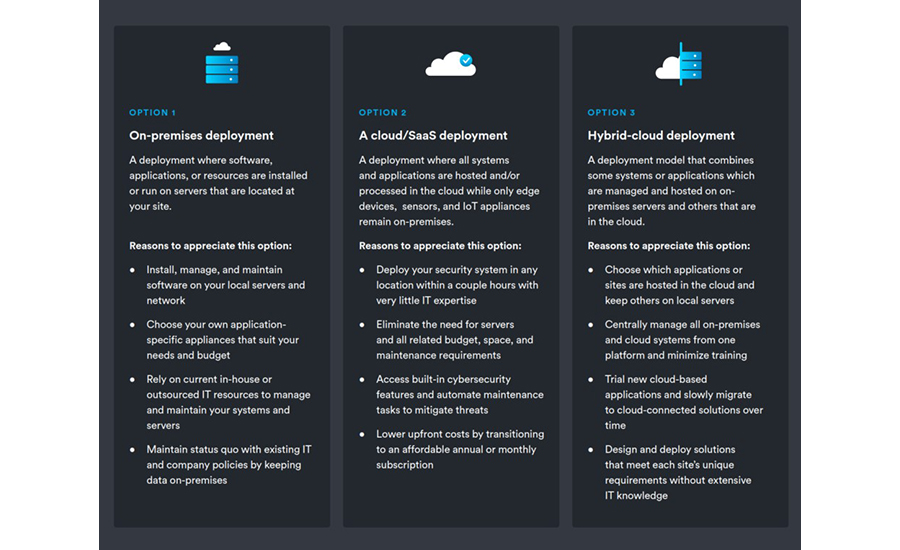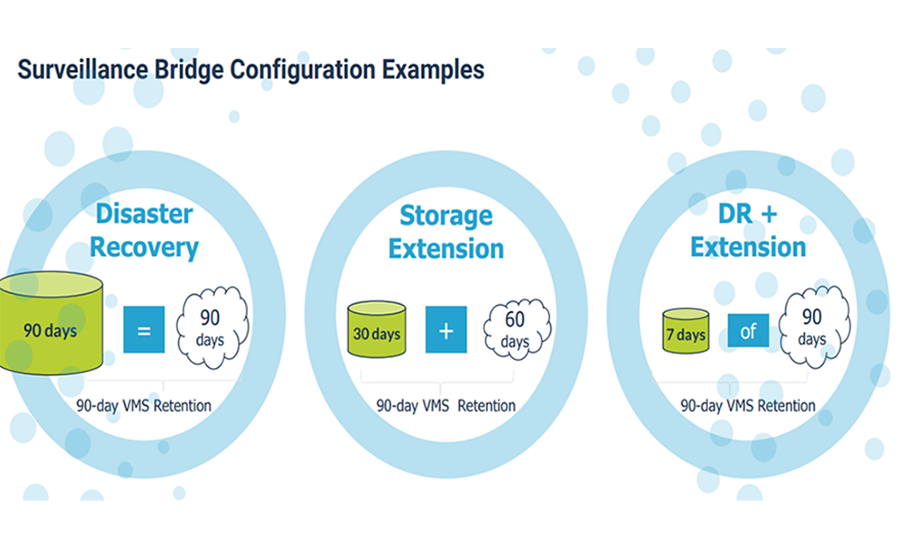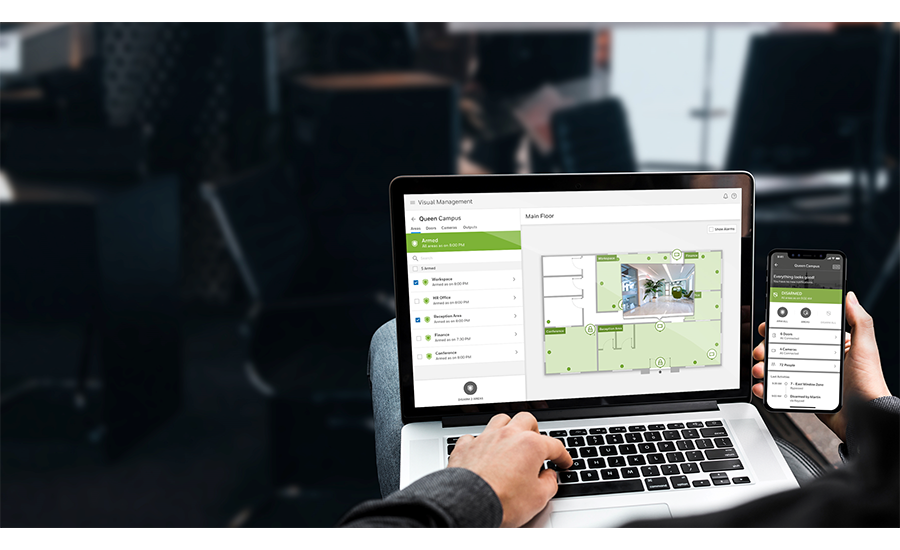Cloud solutions for video surveillance aren’t and never were black-and-white options. Rather, cloud-based video can be set up in many different configurations — with hybrid cloud being the most common and fastest growing. There are solutions for practically every end-user customer in one form or another.
The right solution for some end users, however, is no cloud at all — strictly an on-premises video surveillance system. And that’s why having answers for which type of video surveillance model is best for which applications is essential among security integrators.
Configurations of video surveillance systems range from fully on-premises (sometimes called on-prem), where all of the hardware, applications, management and storage are done exclusively at the customer’s site; to a hybrid solution where some components/operations occur on-site and others in the cloud; to fully cloud-based. Some vendors look at this range of solutions on a continuum, with on-prem systems at one end of the spectrum and full cloud at the other end — and a great number of hybrid cloud solutions in between.
Sanjay Challa, chief product officer, Salient Systems, Austin, Texas, points out that the configurations at either end of the spectrum are extremely polarized in that with full-cloud systems you don’t have an experience without the internet and with on-premises systems you only have an experience without the internet.
While full cloud gives end users the ability to perform many functions remotely, its “Achilles heel” is video data ownership, vendor lock-in, cost and reliability issues, Challa says.
“You have that internet outage — oh, well, good luck. You decide you don’t want to renew with that vendor — ouch, there are some lock-in and cost issues. You want to pull all of the data that you have — hmm, those egress fees. First, you don’t own your data and second, it might be kind of challenging to pull it all out,” Challa says.
Some of these factors might not matter at all, though. For very small businesses, “easy is the way to go and they don’t care about owning their video surveillance data,” Challa observes.
The factors important to end users at the opposite end of the spectrum are ownership and control of the video, as well as flexibility in how they deploy and manage some of the components. Doing things completely offline, disconnected from the internet and from cloud services, allows complete control but may impede remote services. “At the end of the day, there’s just a trade-off. You’re trading easiness with ownership and control,” Challa says.

On-Premises Solutions
The advantage of on-prem systems is having complete control. Users have direct physical access to the infrastructure and video when needed and the ability to realize their specific security requirements, says Jeremy White, founder of Pro-Vigil, San Antonio, Texas.
“One disadvantage is that on-premises resources are typically accessible only from within the organization’s network. Another disadvantage of on-prem is it requires a significant upfront investment to buy the hardware and software required, as well as pay for the ongoing maintenance, updates and security,” White says.
For large Fortune 500 and multinational organizations, data sovereignty is a very important aspect of their operations as it affects video streams, Challa explains. This includes factors such as where the data resides, compliance with data privacy laws, and building a corporate data lake by leveraging the video data with corporate business intelligence. “So, probably anything further right of hybrid or cloud-enabled doesn’t make sense,” he says.
For these reasons, integrators who serve this part of the market shouldn’t be considering “no-footprint” or bridge-based solutions that rely solely on the cloud. Instead, they should look at traditional or hybrid and cloud-enabled solutions, Challa advises.
“I’d think more about how the cloud can help them with operational processes like license management and system health reporting. Those are great things to do through the cloud while allowing these large multinational corporations to still worry about how they store and manage what they consider one of the most critical data assets that they have,” Challa says.

Cloud Solutions
Conversely, cloud solutions often make sense for companies with small systems, such as those with up to eight cameras. Ideal applications for cloud solutions are end users who don’t place big demands on their system. They don’t need a huge server or massive storage space, and may not even have a server rack for an NVR, says Aaron Saks, senior technical marketing and training manager at Hanwha Vision America, Teaneck, N.J.
“For them, a system that is either direct-to-cloud where it’s just cameras, or a somewhat hybrid system where there’s an on-site gateway, works perfectly for them,” Saks says. The gateway is a small box that allows data to be stored locally in case of internet problems and can throttle bandwidth based on time of day, Saks explains.
He describes the attributes of the cloud that make it ideal for surveillance at many types of facilities: it is flexible and elastic, scaling to the end users’ needs and resources. “If they’re recording 30 days now, but in a few months or seasonally they need 60 days, they just log in, click a few buttons and they’re done. They don’t need anyone to come on-site and change out hard drives,” Saks says.
Hybrid Solutions
This flexibility and scalability allow end users take advantage of the significant cost savings offered by tiered cloud video storage, says Jennifer Hones, manager, Key Account Team, Milestone Systems, Portland, Ore. Hybrid is an ideal way for many users to put toes in the water with cloud video.
Hones describes the hybrid cloud model as one that combines on-premises, edge-based storage and processing with cloud-based services. “This model helps minimize bandwidth usage since only relevant footage (like alarm-triggered clips) is uploaded to the cloud while maintaining continuous local recording,” Hones describes.
There are other models, as well, which address different corporate structures and suit a range of policies. In a multi-site hybrid deployment, there may be a mixture of on-prem, scalable infrastructure at an organization’s larger sites, while their smaller, remote sites are fully cloud-based and are connecting to the head end, describes Laurent Villeneuve, senior product marketing manager at Montreal-based Genetec.
“A lot of customers are asking for this kind of approach, where their full large-scale operations need to remain intact,” Villeneuve says. “They want it to evolve but they don’t want to lose all the enterprise functionality, all the storage that they’ve invested in over the last decade. But they do have new sites to spin off and they will benefit from cloud capabilities for these smaller sites.” He adds that the sectors interested in such a configuration include enterprise, retail, banking and others like these.
Then there is an on-premises-first kind of deployment, but with added cloud capabilities, such as video recording infrastructure that has cloud storage for redundancy or for longer term storage. Connectivity — for cloud updates or maintenance services — could also be part of such a solution.
“You are benefiting from some cloud capabilities, keeping your things up-to-date and secure and easier to manage, but you still have some on-prem servers to store your video because in many cases the bandwidth is just not there yet and we’re not going to force customers to opt for cloud if it doesn’t work,” Villeneuve says.
Starting again with an on-premises-first configuration, an end user then could do cloud add-ons. They would manage their VMS on-site with their core security team. If they want to send video to an investigation team located elsewhere or share it with law enforcement, then can do that easily and through the cloud, he notes.
“I think evidence management is a really good complement to VMS. You could also think about access and identity management; that also can be fully cloud-based,” Villeneuve says.

Full Cloud
A fully hosted, fully cloud-based solution is likely to be called “direct-to-cloud.” It involves connecting a cloud-ready camera or other security device, and all the playback and storage is done in the cloud with native cloud services, Villeneuve describes. “That’s on top in terms of cloud.”
This configuration also may be called Video Surveillance as a Service (VSaaS). With it, the management and storage of video data, along with analytic tools, is entirely in the cloud. VSaaS is well-suited for small- or medium-sized organizations with multiple locations, smaller camera-channel counts, and end users who need fast/easy cloud deployments, Hones says.
The advantages are ease of use and scalability, as well as cost savings over time, since it eliminates the need for hardware infrastructure, Hones says. “However, VSaaS can pose bandwidth challenges because constant video streaming to the cloud can consume considerable network resources. Also, the quality of service is heavily dependent on the quality of the internet connection,” she explains.
A totally cloud-based video surveillance solution offers easy storage, streaming and analytics, and makes it easy to expand or contract the size of the end user’s system. Users can access video feeds from anywhere with an internet connection, describes Brad McMullen, president, 3xLOGIC, Fishers, Ind. It also provides redundancy and back-ups, ensuring data integrity and minimizing the risk of data loss.
“Continuous video streaming relies on a stable internet connection, though,” McMullen emphasizes. “Significantly, storing video data in the cloud often raises concerns about data privacy, potential breaches or unauthorized access. Robust security measures must be implemented to mitigate these risks.”
The bottom line is that embracing cloud video solutions can benefit not only end users, but security integrators in multiple ways, says T.J. Dickson, vice president of marketing, Speco Technologies, Amityville, N.Y.
“Cloud-based solutions use subscription-based pricing, providing predictable recurring revenue that increases bottom-line profitability and the overall value of the business,” Dickson says. “Integrators can save on maintenance and support costs with fewer on-site visits and reduced hardware. Overall, embracing cloud video solutions enables integrators to expand offerings, generate recurring revenue, and lower costs while enhancing customer relationships.”



